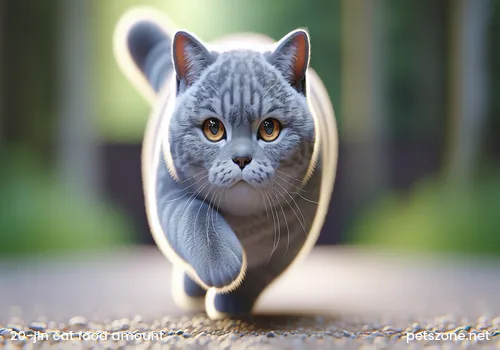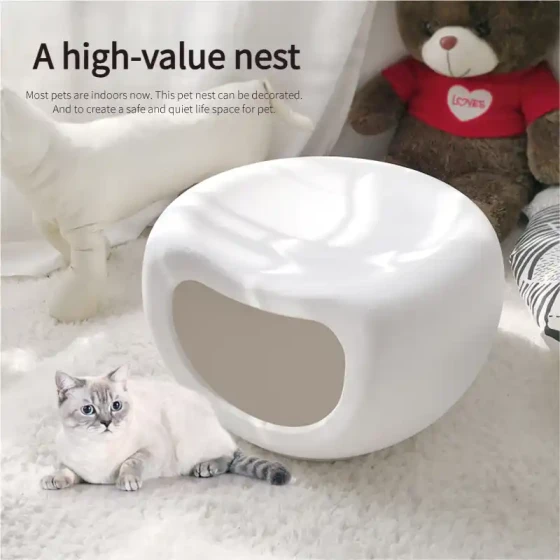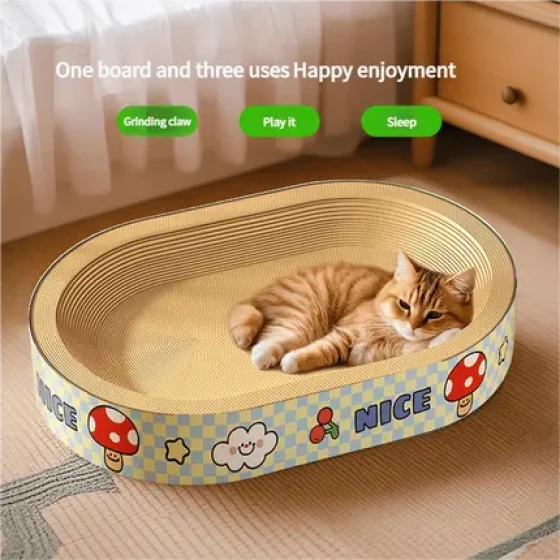How Much Cat Food Does a 20-Jin Cat Eat in a Day_Scientific Calculation Guide for Adult Large Cats’ Daily Food Intake
For an adult large cat weighing 20 jin (about 10 kilograms), determining the appropriate daily amount of cat food requires comprehensive consideration of factors such as its age, weight, activity level, and the energy density of the cat food itself. Simply put, there is no fixed feeding amount suitable for all 20-jin large cats; scientific calculation and personalized adjustment are necessary.
Generally speaking, the daily calorie requirement for an adult cat can be estimated by a formula: Daily calorie requirement (kcal) = 70 × (weight in kg)^0.75. This formula calculates the resting energy requirement (RER) of the cat. However, this is only a base value, and it needs to be multiplied by an activity factor according to the cat’s actual situation to get the daily total energy requirement (DER).

For a cat weighing 10 kilograms, first calculate its resting energy requirement (RER).
RER = 70 × (10)^0.75 ≈ 70 × 5.62 ≈ 393.4 kcal/day.
Next, you need to choose an appropriate activity factor based on the cat’s activity level and physical condition.
* Neutered adult cats / normal activity: activity factor usually between 1.2-1.4.
* Intact adult cats / normal activity: activity factor usually between 1.4-1.6.
* Inactive / prone to obesity cats: activity factor may be between 0.8-1.0 (sometimes calculated using ideal body weight’s RER).
* Active adult cats: activity factor may be between 1.2-1.4.
Assuming this 20-jin (10 kg) large cat is neutered and normally active indoors, we can select an activity factor of 1.2.
Then, its daily total energy requirement (DER) ≈ 393.4 kcal × 1.2 ≈ 472 kcal.
Knowing the total daily calorie needs, next check the "metabolizable energy" (ME value) on your cat food packaging, usually expressed in kcal/kg or kcal/100g. Suppose the cat food you use has an energy content of 4000 kcal/kg (i.e., 4 kcal/g), then the daily feeding amount can be calculated using the following formula:
Daily cat food feeding amount (grams) = Daily total energy requirement (kcal) / Cat food energy density (kcal/g).
Daily cat food feeding amount ≈ 472 kcal / 4 kcal/g ≈ 118 grams.
This means a 20-jin (10 kg), neutered, normally active adult large cat needs about 118 grams of cat food per day. However, this is only a starting amount based on an estimate formula; in actual feeding, adjustments should be made based on the cat’s weight changes, body condition, and mental state.
Main Factors Affecting a Cat’s Daily Food Intake
Determining a cat’s daily food intake is not fixed; the following key factors significantly affect feeding amounts:
- Weight and Body Condition Score (BCS): Although the title mentions a 20-jin large cat, it is important to judge whether this 20 jin is healthy muscle or excess fat. Veterinarians usually use a body condition score to assess the cat’s fatness, ranging typically from 1 to 9, with an ideal score around 5. If your cat is overweight, caloric needs may be calculated based on its ideal weight, reducing feeding to help with weight loss. Conversely, if the cat is underweight, feeding may need to be increased.
- Age: Kittens, due to rapid growth and high metabolism, require significantly more calories and nutrients than adult cats. Senior cats may need reduced amounts due to slower metabolism and less activity, but still require high-quality protein to maintain muscle mass.
- Activity level: Active cats, like members of the “cat parkour team” who jump around all day, expend more energy and need increased food amounts. Lazy “couch potato” cats with low activity levels require less food to prevent obesity.
- Neutering status: Neutered cats have slower metabolism, typically reducing calorie needs by 20-30%, but may have increased appetite, necessitating controlled feeding amounts.
- Health status: Pregnant or nursing queens require significantly more nutrition for themselves and their kittens. Sick or recovering cats may have special dietary needs. Chronic conditions such as diabetes or kidney disease require feeding plans under veterinary guidance.
- Food type and energy density: Different brands and types of cat food (dry, wet, raw/bone-in) vary widely in energy density. Dry food is usually more calorie-dense, wet food has higher moisture thus lower energy density, and raw/bone diets have specific calculation formulas. Always refer to the feeding guide on the food packaging.
- Feeding frequency: Cats naturally prefer multiple small meals; feeding 2-4 times daily is recommended.
How to Scientifically Feed Adult Large Cats
- Calculate the basic feeding amount: Use the calorie formula combined with the cat’s weight and activity to estimate the daily total energy requirement, then calculate the approximate daily cat food amount based on the food’s energy density.
- Refer to cat food packaging guidelines: Most reputable cat food packages provide recommended feeding charts based on weight and activity levels as a reference.
- Feed multiple times daily: Divide the total daily amount into 2-4 meals, feeding on schedule and in fixed quantities.
- Observe the cat’s body condition and mental state: This is the most direct method. Weigh your cat regularly (e.g., weekly), observe body condition (ribs palpable without prominence, waist curves visible), mental alertness, and appetite. If weight steadily increases or decreases, or if lethargy or poor appetite occurs, feeding amounts may need adjustment or veterinary consultation.
- Adjust gradually: If feeding changes are needed (for weight loss or gain), avoid sudden large changes; adjust gradually to allow the cat’s digestive system to adapt.
- Provide sufficient clean drinking water: Whether feeding dry or wet food, ensure fresh water is always available. Especially for cats mainly fed dry food, water intake is critical to prevent urinary problems.
- Avoid excessive treats: Treat calories should be included in the total daily calorie intake, and treats should not exceed 10% of daily calories.
- Regular health check-ups: Take your cat to the veterinary hospital yearly for health exams, allowing vets to assess the cat’s condition and provide professional feeding advice. The World Small Animal Veterinary Association (WSAVA) also offers nutrition assessment guidelines for cats as references.
How to Tell if a Cat Is Full?
Cats usually know when they are full. They show some signals after eating enough:
- Slow down or stop eating: No longer wolf down food, start to chew slowly or walk away from the food bowl.
- Lose interest in food: No longer circle the bowl or meow to beg for food.
- Lick paws or groom: Some cats clean themselves after eating, including licking their paws. This may be an instinctive behavior to aid digestion or stay clean.
- Become lazy, look for a resting place: After eating and drinking, cats usually find a comfortable spot to sleep or relax.
- Symbolically “bury” food: This is an instinct from wild cats to store food.
Conversely, if the cat remains restless, frequently searches for food, or meows at you and the food bowl after finishing a meal, it may mean it is not yet full.
Frequently Asked Questions
- Why does my 20-jin cat still look skinny?
Weight is only a reference point; body condition score is more important. If the cat has a large frame, 20 jin may be a normal weight. Feel the ribs and observe the waistline to judge condition. If concerned, consult a vet for a professional assessment. - Can I free-feed my cat?
For cats that maintain normal weight easily, free feeding (food always available in the bowl) is acceptable since cats naturally eat small amounts frequently. However, for overweight or weight-controlled cats, scheduled feeding is recommended to avoid overeating. - What happens if a cat eats too much?
Short term may cause digestive upset, vomiting, soft stools, or diarrhea. Long term overfeeding leads to obesity, increasing risk of diabetes, heart disease, arthritis, and seriously affecting health and lifespan. - Are feeding amounts on cat food packaging accurate?
The packaging amounts are averages for reference only. Actual feeding amount must be adjusted according to the individual cat’s condition. - Which is better, wet or dry food?
Both have pros and cons. Wet food’s high moisture helps hydration and urinary health, may help weight control. Dry food is convenient, helps clean teeth. Mixing dry and wet feeding balances benefits. Whatever you choose, ensure the food meets AAFCO or similar nutrition standards for complete and balanced nutrition.
Scientific feeding is key to a cat’s health and longevity. For a 20-jin large cat, it is especially important to patiently observe, calculate, and adjust the daily food amount, ensuring they eat healthily and live comfortably!


-560x560.webp)
-560x560.webp)